DC really did them right…
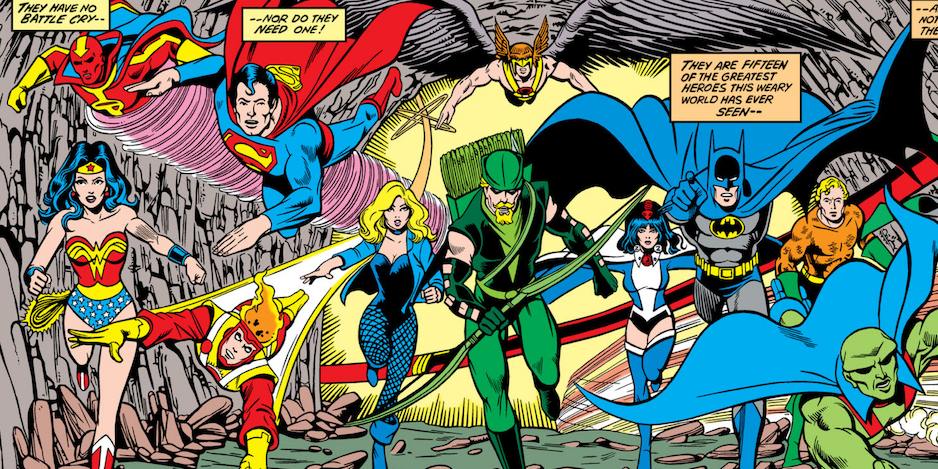
—
UPDATED 9/23/25: I have no specific reason to reprint this one from September 2020 right now, other than it’s a great column by Anthony Durso and I just felt like sharing it again. Dig it! — Dan
—
On Tuesday, DC releases Detective Comics #1027, which purports to celebrate Batman’s 1,000-issue anniversary in the book that introduced him. Really, it’s a glorified excuse for another Batman anniversary ish because the math actually doesn’t fit. But, really so what: The number 27 is magical where Detective is concerned and so #1027 has a certain ring to it.
Now, DC has a particularly strong history of anniversary issues, so I asked 13th Dimension contributor Anthony Durso — he of The Toyroom and Retropolis Tees — to rank the 13 best. He narrowed it to the Bronze Age because it was in many ways the Golden Age of DC anniversary issues.
Dig it.
—
By ANTHONY DURSO
I LOVE anniversary issues! They hold not only a special place in a company and character’s history but in my mind as well. There was always something exciting about cracking open one of these DOUBLE-SIZED events. And if that famous golden ANNIVERSARY ISSUE banner (from the early ’80s) was peaking out on the top of the spinner rack, you grabbed it (it adorns five of the following issues).
Here are THE TOP 13 DC (BRONZE AGE) ANNIVERSARY ISSUES — RANKED:
—
13. ADVENTURE COMICS #500 (June 1983)
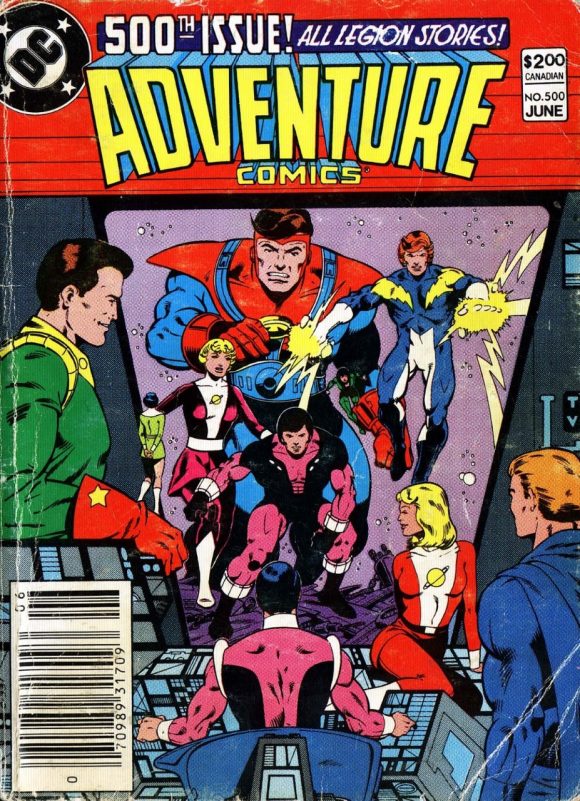
How’d We Get Here? Originally known as New Comics (pubdate Dec. 1935), the anthology series became New Adventure Comics with Issue #12, and dropped the “New” with Issue #32. Many series were launched in Adventure Comics over the years, with the Legion of Super-Heroes being the most successful and popular. Debuting in Adventure Comics #247 (April 1958) in the Superboy feature, the LSH would guest star in the Boy of Steel’s strip many times before becoming the outright headliner of the book with Issue #300 (Sept. 1962) and would hold that spot until #380 (May 1969). Although Adventure Comics was the oldest DC comic being published at the time, it wasn’t the first to reach the magical number 500, due to bi-monthly publication at points throughout its run.
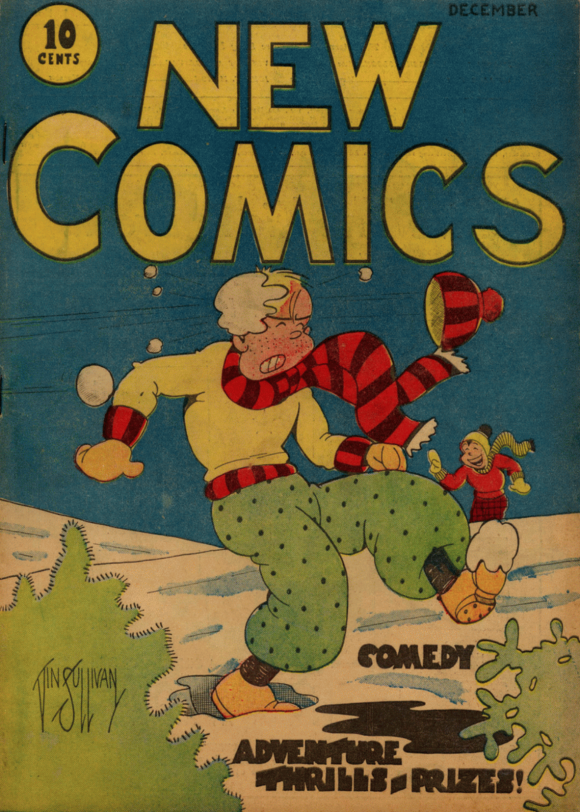
The Stories: When Adventure Comics was converted to a digest with #491 (Sept 1982), it featured new stories as well as reprints from its long run. The most popular series reprinted, of course, was the Legion of Super-Heroes. With the 500th issue, Adventure was doubled in size and featured all Legion reprints (from the original run of Adventure Comics #305-311). A flip cover showcased the Silver Age LSH viewing their modern counterparts on a video monitor, while the reverse was featured on the back cover.
Notes: Although it would have been nice to have had a full-size comic commemorating the various features that had appeared in Adventure Comics over its 500 issues, we’re lucky we got anything at all, considering how little attention DC gave the title toward the end of its run. That being said, it’s very fitting that the Legion was given the task of carrying the load for this anniversary Issue, as it’s probably the feature most identified with the title. Unfortunately the book only lasted three more issues before it was cancelled. It was briefly revived in 2009 and ran for 13 issues. Its only feature? The Legion of Super-Heroes.
—
12. THE BRAVE AND THE BOLD #200 (July 1983)
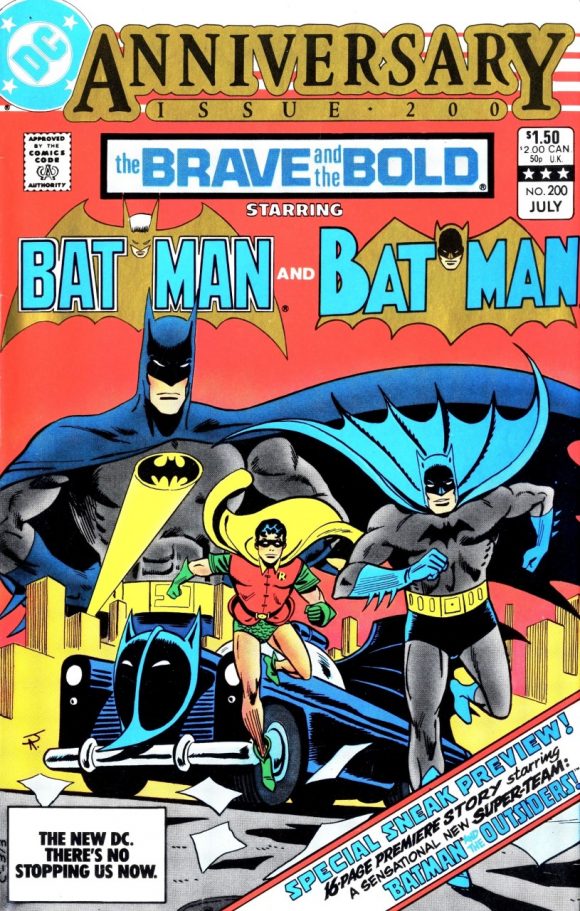
How’d We Get Here? The Brave and the Bold began as an tryout title in August 1955. By #50 (Nov. 1963) it became a team-up book, featuring various DC heroes. Batman made his first non-JLA appearance in the book in #59 (teaming up with Green Lantern) and eventually became the permanent co-star with #74.
The Story: This anniversary Issue is also the last issue. After 28 years, DC decided to replace the Batman team-up title with… a Batman team-up title. Batman and The Outsiders (which gets a 16-page preview in this very issue*) would replace the title on the stands the next month.
So they decided to go out with a bang (by writer Mike W. Barr and artist Dave Gibbons) and have Batman team-up with himself…sort of. On Earth-Two, Batman had encountered Nicholas Lucien, also known as Brimstone, in the 1950s. Lucien had eventually fallen into a coma and, upon his reawakening, discovered that Batman was dead. Using his mind, he then possessed his Earth-One counterpart and battled that Earth’s Batman. Batman wins out in the end and Lucien’s mind returns to his original decrepit body back on Earth-Two. And scene.
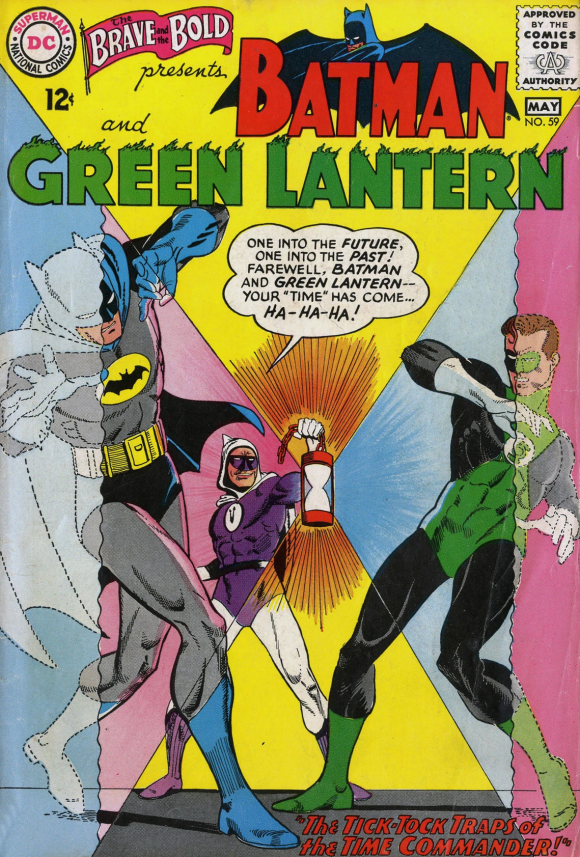
Notes: Although it’s billed as a Batman/Batman team-up, the two heroes never actually wok together in this issue as their stories each take place in different eras. In fact, I don’t believe the Earth-One and Earth-Two Batmen EVER worked together. E1 Batman teamed with other members of the E2 Batman Family but never the original Caped Crusader.
Dave Gibbon was a great choice to do the art for both the modern Batman and early Silver Age version, altering his style for each. However, it’s kind of a letdown that this was an anniversary issue AND final issue and Jim Aparo (the book’s regular artist for years) only got to do the cover. Maybe he needed the extra time to do the BATO preview in this issue.
* The 16-page preview of Batman and the Outsiders is a typical tale of the team working together as we’re introduced to them for the first time. Halo, Katana and Geo-Force make their debut, while Black Lightning and Metamorpho are old acquaintances of Batman from the pages of Brave and the Bold. And although it’s a preview, the story actually takes place after Issue #3 of the main series. BATO was a favorite book during the ‘80s, but it was still a gut punch that it took the place of Brave and the Bold.
—
11. SUPERMAN FAMILY #200 (April 1980)
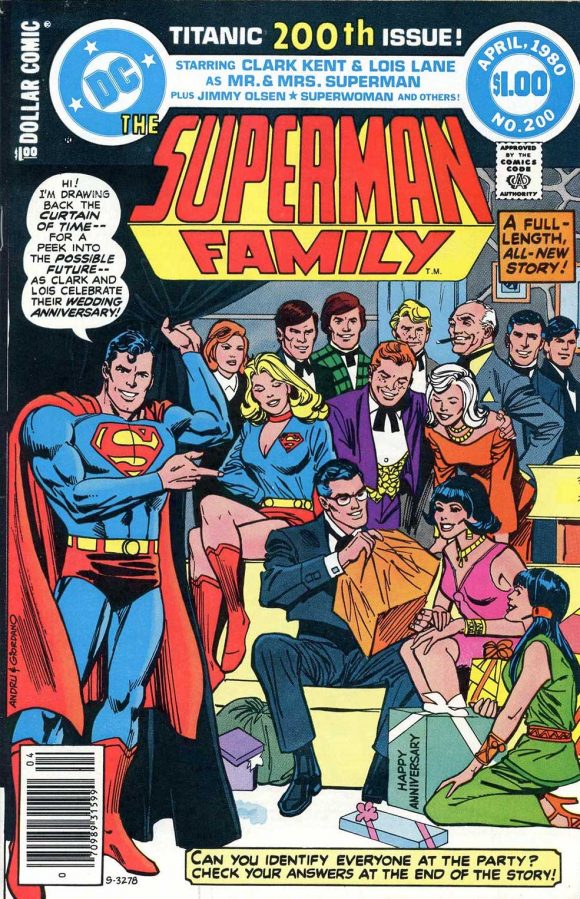
How’d We Get Here? Superman’s Pal Jimmy Olsen debuted in October 1954 and ran until #163 (March 1974). Superman’s Girlfriend Lois Lane began in April 1958 and ran until #139 (October 1974). Supergirl’s short-lived solo title ran for 10 issues, from November 1972 until October 1974. All were cancelled and merged into Superman Family, which picked up Jimmy Olsen’s numbering beginning with Issue #164, as of May 1974.
The Stories: Writer Gerry Conway takes us 20 years into the future (the year 2000!) to celebrate the wedding anniversary of Clark Kent and Lois Lane. Each chapter focuses on a different member of the Superman Family and what their lives are like in the future.
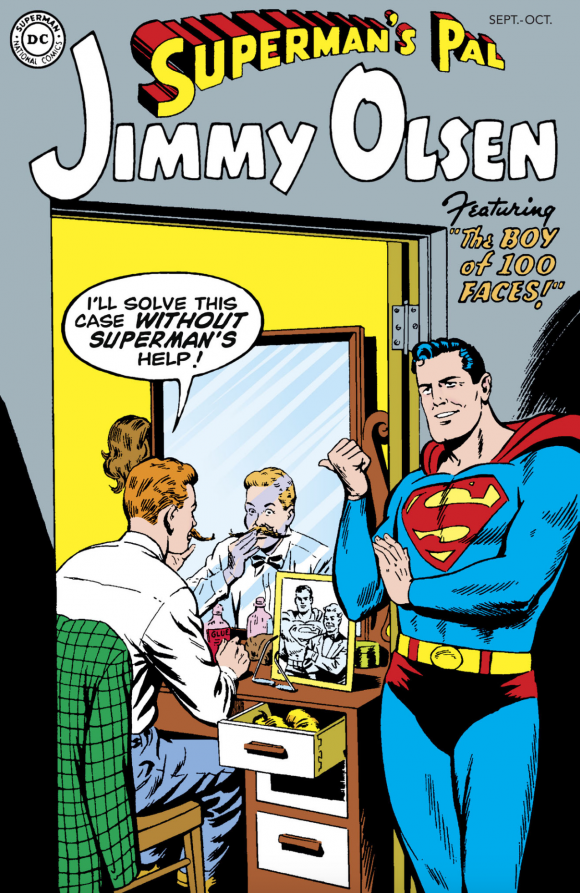
Lois Lane (art by Bob Oksner) has been a columnist instead of an investigative reporter for the last 16 years while she stayed home to raise her daughter, Laura Kent. Laura is a pig-tailed, mini-skirted teenager who is the spitting image of her mother. If she has any characteristics of her father, Clark Kent (aka Superman), they haven’t developed… yet.
Jimmy Olsen (art by Alex Saviuk) is married to Lucy Lane and is the publisher of The Daily Planet.
Clark Kent (art by Kurt Schaffenberger) is still a reporter for a great metropolitan newspaper, but he might just be ready for retirement.
The former Supergirl, is now known as Superwoman (art by Win Mortimer) and is the governor of Florida in her secret identity of Linda Danvers. She has a sleep-over boyfriend, whose identity is never revealed, his face obscured by shadows.
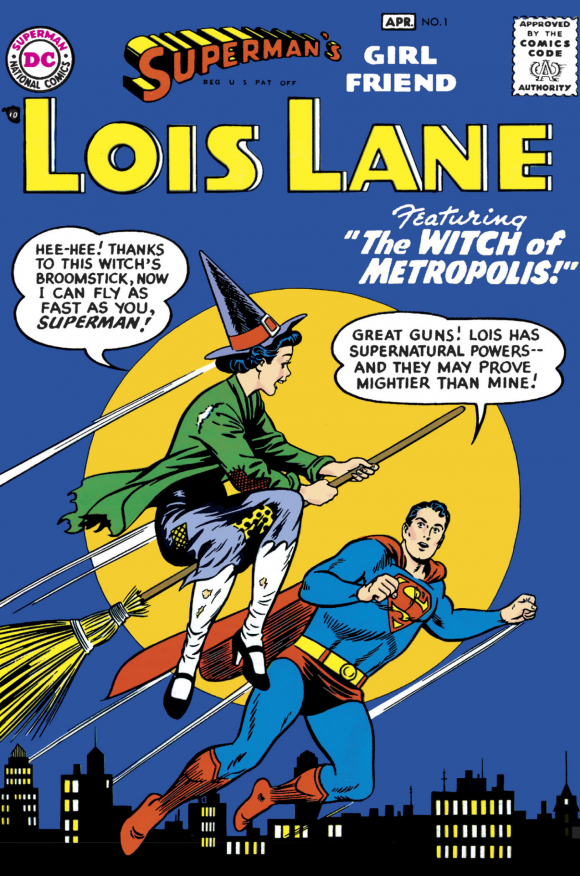
Finally, Mr. and Mrs. Superman’s anniversary party takes place (art by Bob Oksner) and they announce they’re going to be parents again! Only this time, Clark will be the stay at home parent, as Lois revives her career as an investigative reporter. Meanwhile, Laura discovers that she DOES have super-powers!
Notes: There’s nothing really earth-shattering in this issue but it follows the tried and true formulas associated with the various Superman Family features: It’s “soapy”. And that’s not necessarily a bad thing. It would’ve been nice if something further had been done with Laura Kent but as this was an “Imaginary Story,” and one set in the future, she never made it into the main timeline.
—
10. DETECTIVE COMICS #526 (May 1983)

How’d We Get Here? Detective Comics debuted in March 1937 as an anthology series. Batman wouldn’t make his debut in the title until #27 (May 1939). The 500th appearance of Batman in Detective Comics is celebrated in this anniversary Issue.
The Story: In All My Enemies Against Me!, writer Gerry Conway and artists Don Newton & Alfredo Alcala pit the Darknight Detective (and his allies Robin, Catwoman, Batgirl and Talia) against a decent portion of his rogues gallery!
Killer Croc is relatively new to Gotham City (first appearing in Detective Comics #523) and is trying to assert his control over the underworld. The Joker, however, has other plans, and convinces the other villains that they need to strike first and eliminate Batman AND Croc. But nothing goes to plan, as group after group of Bat-villains are defeated by Batman and friends.
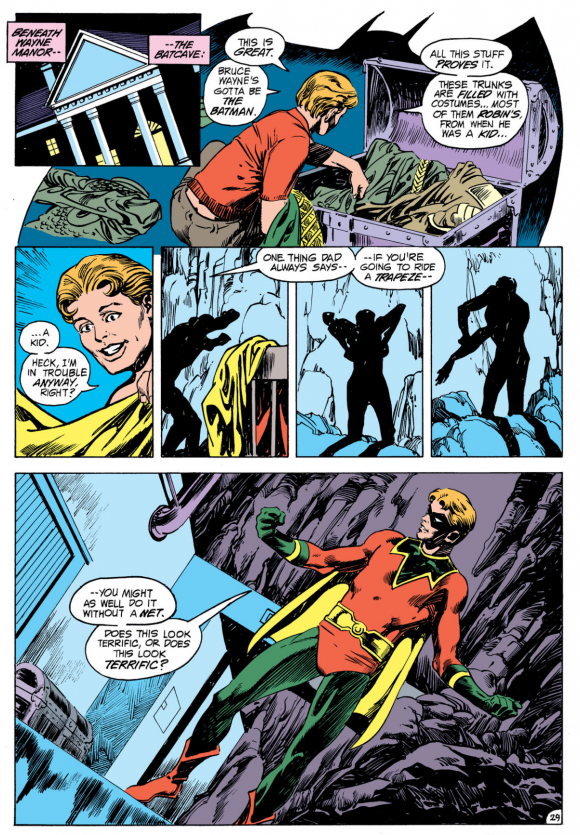
In the midst of all this is young circus acrobat Jason Todd, whose parents, Joe and Trina, have been helping Dick Grayson in his investigations to expose Killer Croc. When Dick discovers that the Todds have gone after Croc on their own, he drops Jason off at Wayne Manor. Jason is left to fend for himself in the mansion and accidentally discovers the Batcave by way of the grandfather clock. There he deduces the true identities of Batman and Robin!
Batman, Catwoman and Talia make a pitstop at the Batcave to use the Batcomputer and when they leave they’re unaware that Jason has hitched a ride on the back of the Batmobile, wearing one of Robin’s old Flying Grayson costumes. Eventually, they catch up with Robin and Batgirl, as well as Killer Croc and the Joker (who has been playing both sides). As Batman and Killer Croc battle to the death, Robin reveals that the Todds have been murdered by Croc. A startled Jason then leaps from his hiding place in the rafters and descends upon Croc, turning the tide of the fight to Batman, who knocks Croc out.
In the aftermath of all the chaos, Dick Grayson, feeling guilt and responsibility for the death of the Todds decides to adopt Jason, but Bruce steps in instead, taking the teenager under his wing.
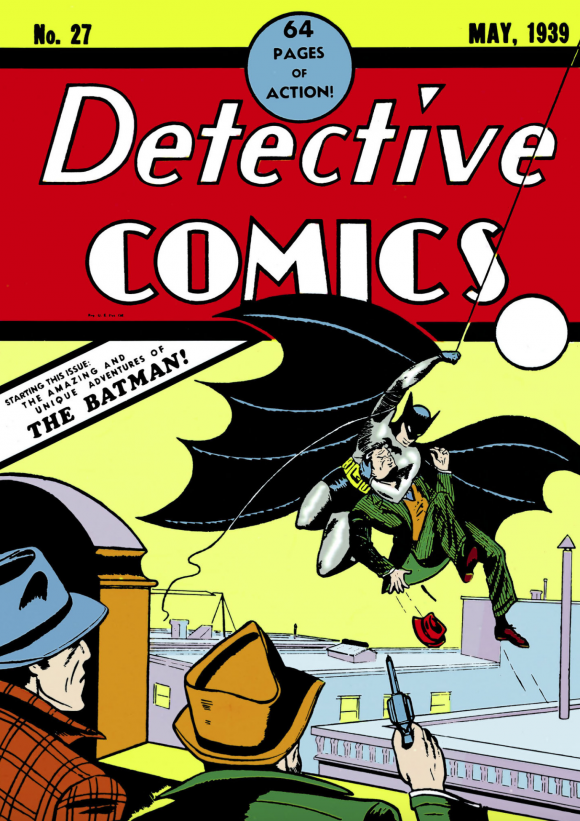
Notes: Although this was the first time Batman went up against all his rogues at once it wouldn’t be the last. The trope was revisited again in Batman #400.
This version of Jason Todd didn’t last long, as, post-Crisis, he was replaced with a different version in Batman #408 (June 1987). That was the version that was infamously killed off by the Joker (via crowbar) and the fans (by phone) in Batman #429 (January 1989).
—
9. LEGION OF SUPER-HEROES (Vol. 2) #300 (June 1983)
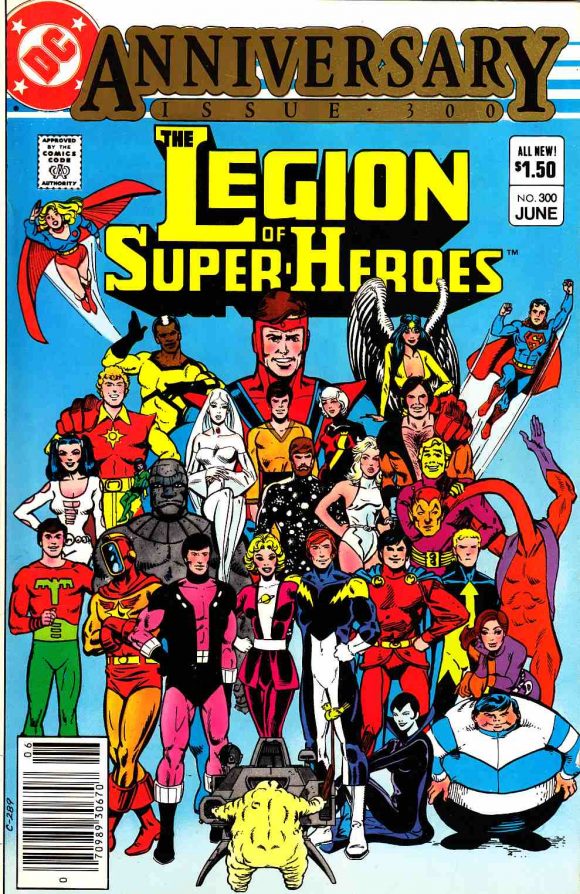
How’d We Get Here? Originally debuting in Superboy’s feature in Adventure Comics, the Legion of Super-Heroes eventually became the Boy of Steel’s co-stars in his own title with Issue #197 (Dec. 1976). By #222, the title officially became Superboy and The Legion of Super-Heroes. When Superboy left the book, it became simply The Legion of Super-Heroes with #259 (Jan. 1980). It’s Volume 2 because there was a four-issue Legion reprint book in 1973.
The Story: Various eras of the LSH are visited in this jam issue (Writer Paul Levitz and framing sequence penciller Keith Giffen are the co-plotters) as the Legionnaires gather to celebrate their anniversary. But visions of past and (possible) future realities keep entering the picture.
The visions are broken down into chapters representing different eras of the Legion. In the first vision (by artist Kurt Schaffenberger) we’re taken back to the Superboy strip when the LSH were just occasional, but frequent, guest-stars. Lana Lang and Pete Ross are there (both honorary Legionnaires) as is Lex Luthor and his robots.
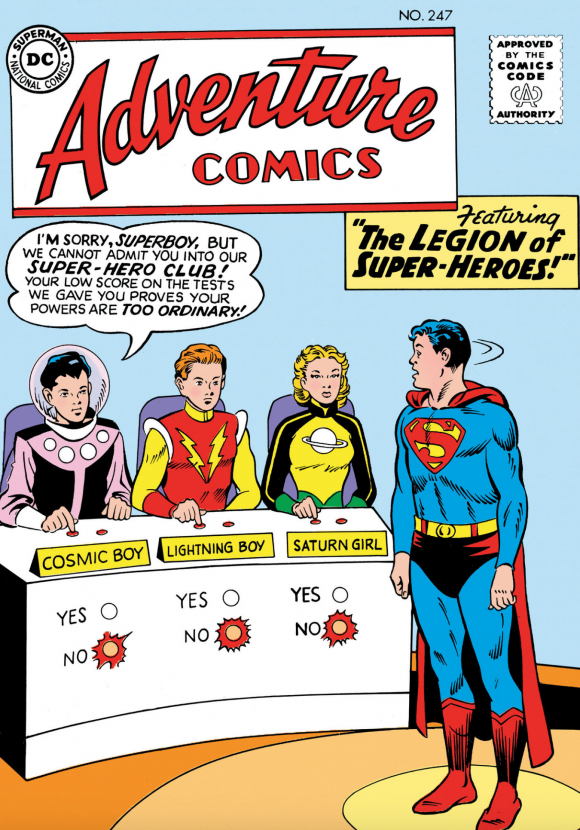
The second vision (by Howard Bender, in a style reminiscent of John Forte) represents the Silver Age Legion when they were given their own feature in Adventure Comics. The villains of the piece are the original trio of the Legion of Super-Villains (Cosmic King, Lightning Lord and Saturn Queen).
The third vision (by long-time Legion artist Curt Swan) depicts the Adult Legion in battle with the Fatal Five and tries to settle once and for all whether the “Adult Legion” tales actually happened or didn’t.
Vision four (by Bronze Age LSH artist Dave Cockrum) features a slighty older team — but not quite the Adult Legion yet — in battle with the Khunds.
The fifth vision (by Bronze Age LSH artist James Sherman) focuses on the Earthwar era of the Legion and their enemies Mordru and the Dark Circle.
Finally, vision six (by Bronze Age LSH artist Joe Staton) takes place during the Blok/Dark Man story arc.
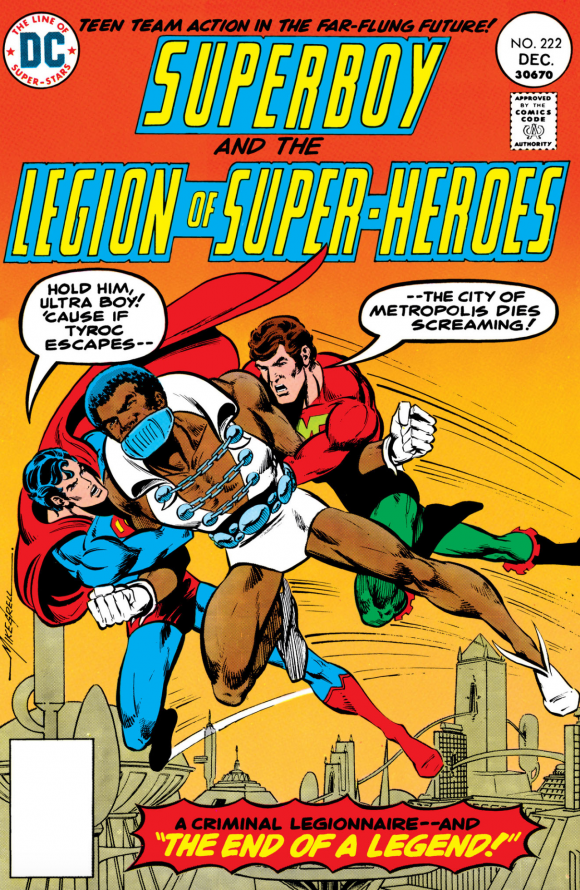
While each of these visions was supposed to represent an era of Legion-past, there were things in each one of them that put them in conflict with the main timeline. Leave it to Brainiac 5 to finally deduce that Douglas Nolan, the brother of deceased Legionnaire Ferro Lad, was trying to find an alternate timeline he wants to live in. He achieves success when he enters a timeline where Ferro Lad dies and Douglas takes his place as a member of the Legion. Sniff.
Notes: This is a great love letter to the Legion of Super-Heroes and everything they represent.
It’s all capped off with a double-page spread (by Keith Giffen and Larry Mahlstedt) featuring the ENTIRE Legion of Super-Heroes, the Legion of Substitute Heroes, the Wanderers, the Heroes of Lallor, honorary Legionnaires and a few Where’s Waldoesque Easter eggs. Whew!
Oh! And the cover is an amazing jam piece featuring all the LSH members, with each one drawn by a different artist. Have YOU figured out who drew who?
—
8. SHOWCASE #100 (May 1978)

How’d We Get Here? Showcase began as a tryout title in March 1956 and originally ran through September 1970 (#93). It was revived in August 1977 and that run ended in September 1978 (#104).
The Story: Scripted by the Two Pauls (Levitz and Kupperberg) with art by Joe Staton, this “Awesome Anniversary Edition” is almost a Crisis on Infinite Earths tryout. Which is more than fitting, considering the nature of the book.
In “There Shall Come a Gathering,” it’s revealed to a roster of heroes (aboard the JLA Satellite) that the space/time continuum is collapsing. While the core team of the Flash, Green Lantern, the Atom, and Adam Strange tackle the problem of Earth being stolen from its orbit, everyone else that’s ever appeared in Showcase pitches in where they can. That includes the Metal Men, Angel and the Ape, the Inferior 5, Bat Lash, Anthro, Tommy Tomorrow, the Challengers of the Unknown, Rip Hunter, the Sea Devils, the Teen Titans, and the Spectre. Even Lois Lane, Fireman Farrell, Windy and Willy and Sugar & Spike get into the act!
Notes: This is such a fun ONE ISSUE romp that really squeezes everyone in and makes it all work. What’s not to like?
—
7. SUPERMAN #400 (Oct. 1984)
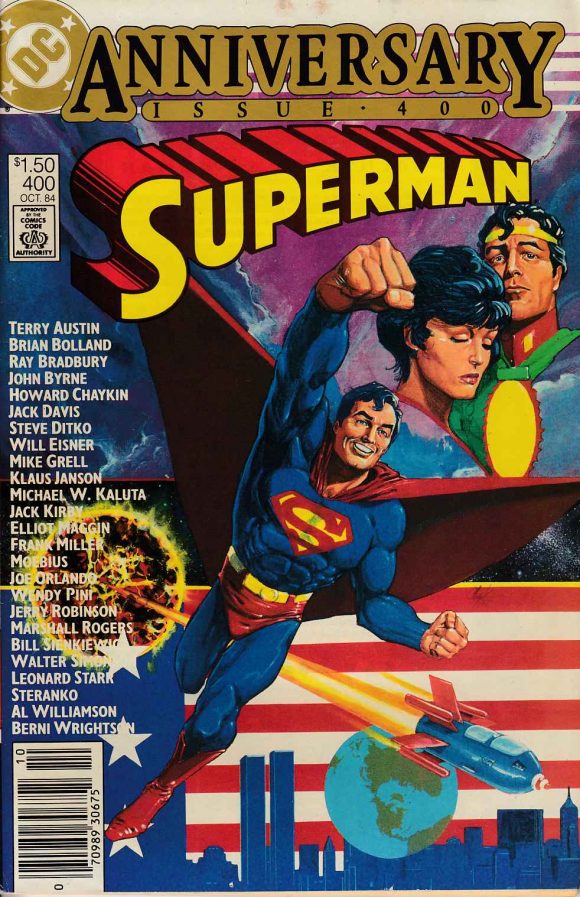
How’d We Get Here? A year after his debut in Action Comics #1 (June 1938), Superman became the star of his own title (June 1939).
The Story: In The Living Legends of Superman, writer Elliot S! Maggin and artists Joe Orlando, Al Williamson, Frank Miller, Marshall Rogers (with Terry Austin), Wendy Pini, Mike Kaluta (with Kelly Adler) and Klaus Jason explore what the Superman legend means across time and space through seven different chapters. There are no super-villains, just ordinary people who’ve been caught up in and inspired by the Superman mythology and his message of hope. In case you didn’t know what the “S” stands for…
A final story with a similar theme, The Exile at the Edge of Eternity is written and drawn by Jim Steranko. It’s basically a prose piece with accompanying splash-style illustrations that feature the spacey messiah exploits of A’dam’mkent, a descendant of Kal-El.
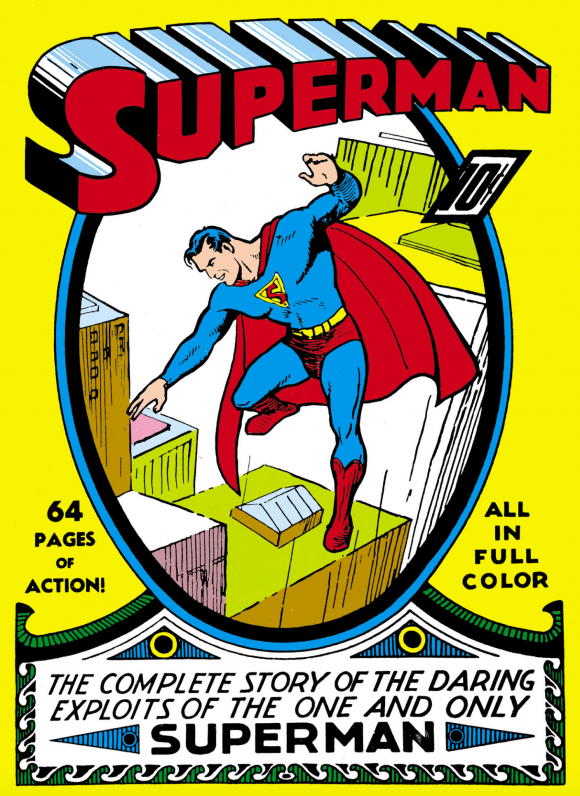
Notes: The book is filled with pinups by Brian Bolland, Jack Kirby with Terry Austin, Jack Davis, Leonard Starr, Walter Simonson, Bernie Wrightson, Will Eisner, Steve Ditko, Mike Grell, Moebius, Bill Sienkiewicz, Jerry Robinson and John Byrne (who’d really leave his mark on Superman in roughly 2 years time). The cover is by Howard Chaykin, with the back cover by Frank Miller. A real Who’s Who of artists, many of whom had never drawn the Man of Steel before.
—
6. WORLD’S FINEST COMICS #271 (Sept. 1981)
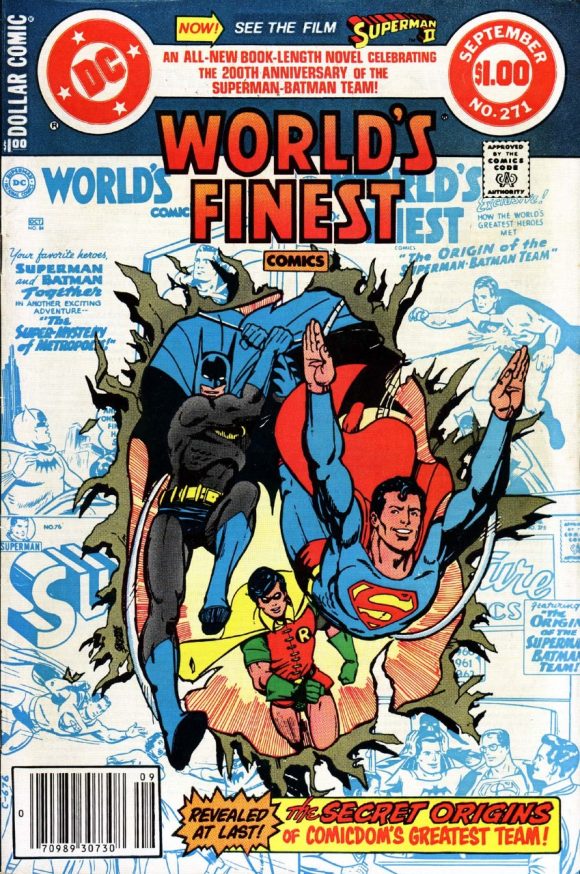
How’d We Get Here? Originally titled World’s Best Comics for it’s first issue, World’s Finest Comics began in March 1941 and featured Superman, Batman and Robin on the cover interacting with each other in various activities like playing sports or selling war bonds. It wasn’t until #71 (July 1954) that the trio were featured in a story together as the Superman-Batman team.
The Story: The 200th anniversary of the Superman-Batman team is celebrated in this Dollar Comics issue, which commemorates the first team-up of Superman and Batman (with Robin) in the pages of #71. But wait — didn’t Superman and Batman first meet outside of the funny pages on the Adventures of Superman radio show? Yes. But didn’t SuperBOY and a young Bruce Wayne first meet in World’s Finest #84? Yes. But didn’t SuperBOY meet Robin FIRST in Adventure Comics #253? Yes. And didn’t Superman and Batman encounter each other for the first time in Superman #76? Yes. In fact, ALL of those (as well as a few others) are true.
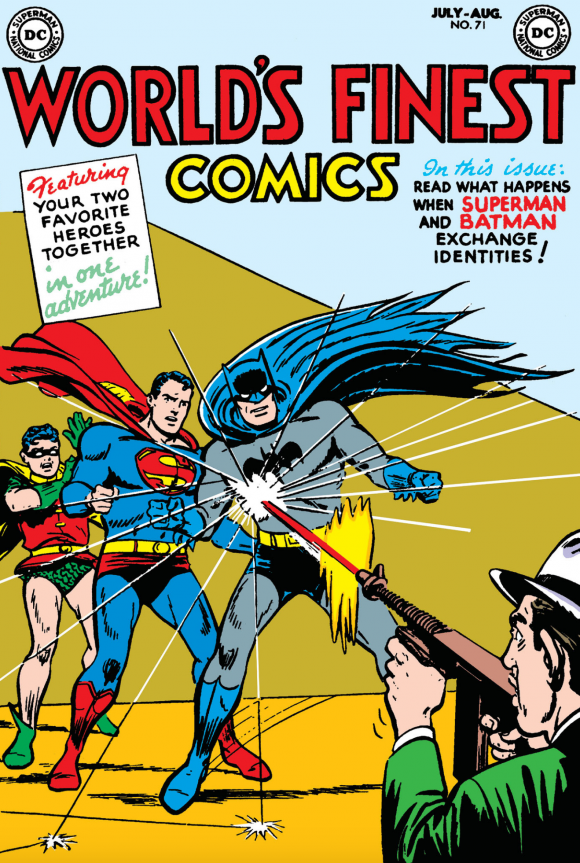
Confused? Don’t worry. Continuity cop Roy Thomas (with help from Jack C. Harris and E. Nelson Bridwell) is on hand (along with artists Rich Buckler and Frank McLaughlin) to set the record straight. While battling a seemingly new foe, Atoman, Superman and Batman discover that they’ve met each other for the first time on more than one occasion. They even manage to drag the Earth-Two Superman and Robin into the mix. (Earth-Two Batman had recently died in Adventure Comics #462 (April 1979).
Notes: It’s not as mind-boggling as it all sounds in a synopsis. Roy Thomas did a great job solving a problem that probably had kept him up at night for many years. I’m pretty sure this is one of the issues a young Geoff Johns read that made him decide he’d like to write comics one day. Awesome cover by George Perez! I’m a sucker for covers where characters are bursting through or interacting on a ghosted wall of old issues.
—
5. DETECTIVE COMICS #500 (March 1981)
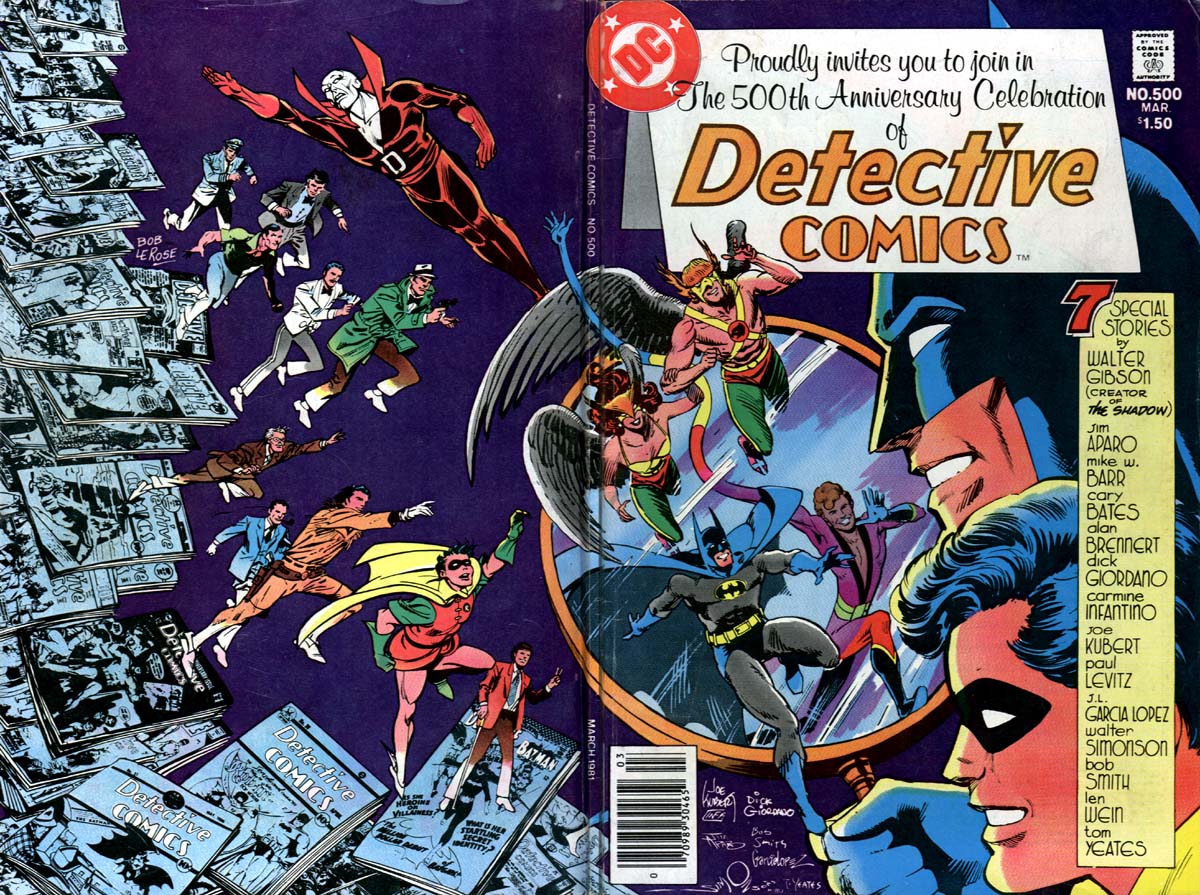
How’d We Get Here? Detective Comics, an anthology title, premiered in March 1937. It’s most famous star, Batman, debuted in #27 (May 1939). Detective Comics is where DC Comics derived its nickname (the company was originally National Comics and later National Periodical Publications).
The Stories:
1. Writer Alan Brennert and artist Dick Giordano give us To Kill a Legend, in which the Phantom Stranger whisks away Batman and Robin to an alternate earth (Earth-5) where they’re given the opportunity to stop Joe Chill from murdering Thomas and Martha Wayne. Successful in eliminating Chill from the equation, Batman is shocked to discover that the Waynes are still scheduled to die! Arriving at Crime Alley in the nick of time, Batman prevents the Waynes from being murdered. But he doesn’t prevent the birth of that Earth’s Batman, as a young Bruce Wayne now vows to fight crime as the Bat-Creature that saved his family. Vengeance has given way to inspiration.
2. Len Wein and Jim Aparo tackle The ’Too Many Cooks…’ Caper. Although Slam Bradley (whose first appearance was in Detective Comics #1) is the headlining star, he’s joined by others (Captain Compass, Human Target, Jason Bard, Mysto the Magician, Pow-Wow Smith and Roy Raymond) who have made the pages of Detective their home over the years.
3. Once Upon a Time… (by Len Wein and Walt Simonson) gives us a little story where all of the captions are taken from the infamous “It Was a Dark and Stormy Night” story “written” by Snoopy (really Charles M. Schulz) in the Peanuts comic strip.
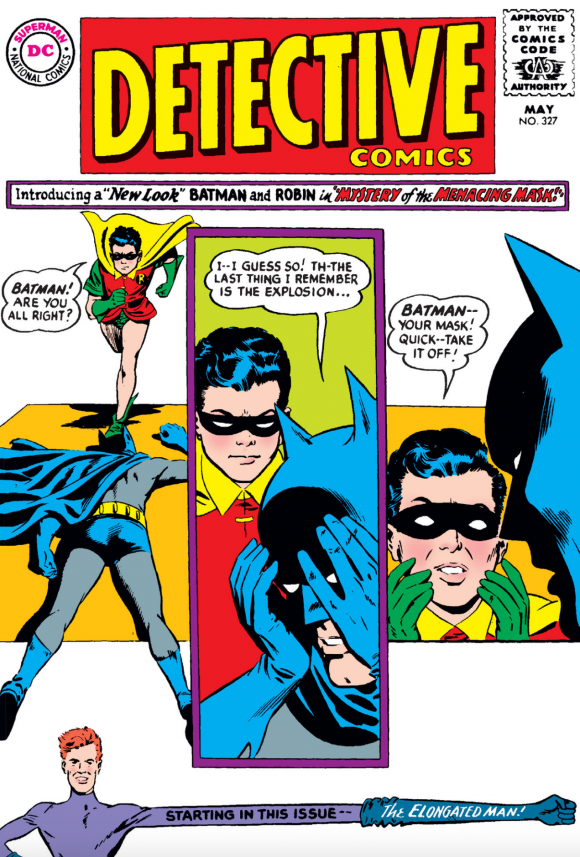
4. The Elongated Man (first backup in Detective Comics #327) stars in The Final Mystery of Edgar Allan Poe” written by Mike W. Barr with art by Jose Luis Garcia Lopez. Edgar Allan Poe is considered the Father of the Detective Story.
5. Walter B. Gibson, the creator of the Shadow (an inspiration for Batman), provides the prose for The Batman Encounters Gray Face, while Tom Yeates contributes accompanying illustrations.
6. Hawkman (first backup in Detective Comics #428) and Hawkgirl team-up to solve The Strange Death of Dr. Erdel, which also ties into the Martian Manhunter (first appearance Detective Comics #225). Written by Paul Levitz with art by Joe Kubert.
7. Batman and Deadman team-up for What Happens When a Batman Dies?, written by Cary Bates with art by Carmine Infantino and Bob Smith.
Notes: The wraparound cover is a jam piece featuring art by all of the aforementioned artists.
The lead story is the first appearance of the character Barbara Kean, the mother of Barbara Gordon and wife of Commissioner Gordon, who featured prominently in the Gotham TV series.
Did we really need a team-up with Deadman that could’ve just as easily been in The Brave and The Bold? Detective was never a team-up title and Deadman was never a feature.
—
4. BATMAN #400 (October 1986)
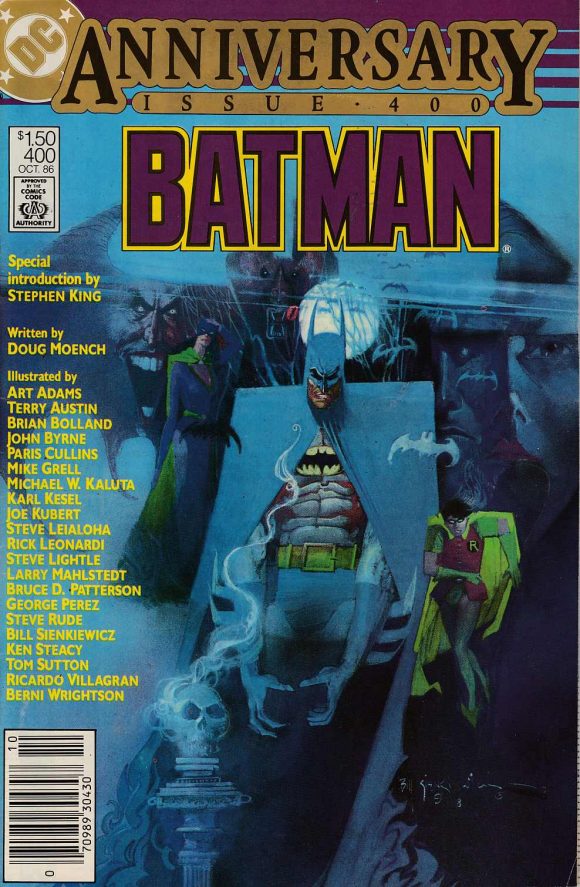
How’d We Get Here? A little less than a year after his debut in Detective Comics #27 (May 1939), Batman became the star of his own title (March 1940).
The Story: More ambitious in scope than the similar villain free-for-all in Detective Comics #526, Resurrection Night (by writer Doug Moench) features Batman and his allies (Robin, Catwoman and Talia…Batgirl sits this one out this time around) as they deal with the threat of a massive jailbreak (Arkham Asylum AND Gotham State Penitentiary) arranged by Ra’s Al Ghul.
To make matters worse, the villains have kidnapped several citizens with close connections to Batman (Alfred Pennyworth and his daughter Julia, Harvey Bullock and Vicki Vale) and have transformed the Gotham City Police HQ into a prison for the police officers. Robin and Talia tackle the GCPD problem while Batman and Catwoman go after the hostages.
All four heroes reunite at Ra’s Al Ghul’s lair, just in time to discover that Ra’s has immersed himself in his Lazarus Pit. After a fierce battle with Batman, Ra’s lands in the Pit a second time and is presumed dead when the whole structure of the building collapses down around him… our heroes escaping in the nick of time.
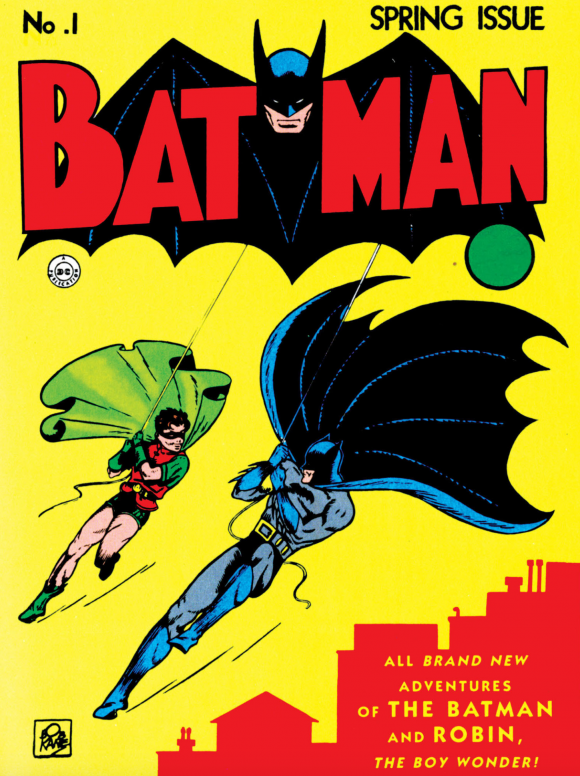
A celebration follows for Batman’s anniversary but, ever the party pooper, he refuses to participate. There are many criminals still out there and he has work to do.
Notes: The artists on the book each take on a chapter and include Steve Lightle, George Perez, Paris Collins, Bill Sienkiewicz, Art Adams, Tom Sutton, Steve Leialoha, Joe Kubert, Ken Steacy, Rick Leonardi, Brian Bolland and John Byrne.
Pinups are provided by Mike Grell, Mike Kaluta, Bernie Wrightson and Steve Rude, with a cover by Bill Sienkiewicz.
This would be the last issue to feature the pre-Crisis Earth-One Batman, as the next issue tied into the post-Crisis event Legends. A few issues later came Batman: Year One.
Doug Moench would be responsible again for the escaped villain routine several years later when he had Bane release all of the Arkham inmates during the Knightfall saga.
—
3. THE FLASH #300 (August 1981)
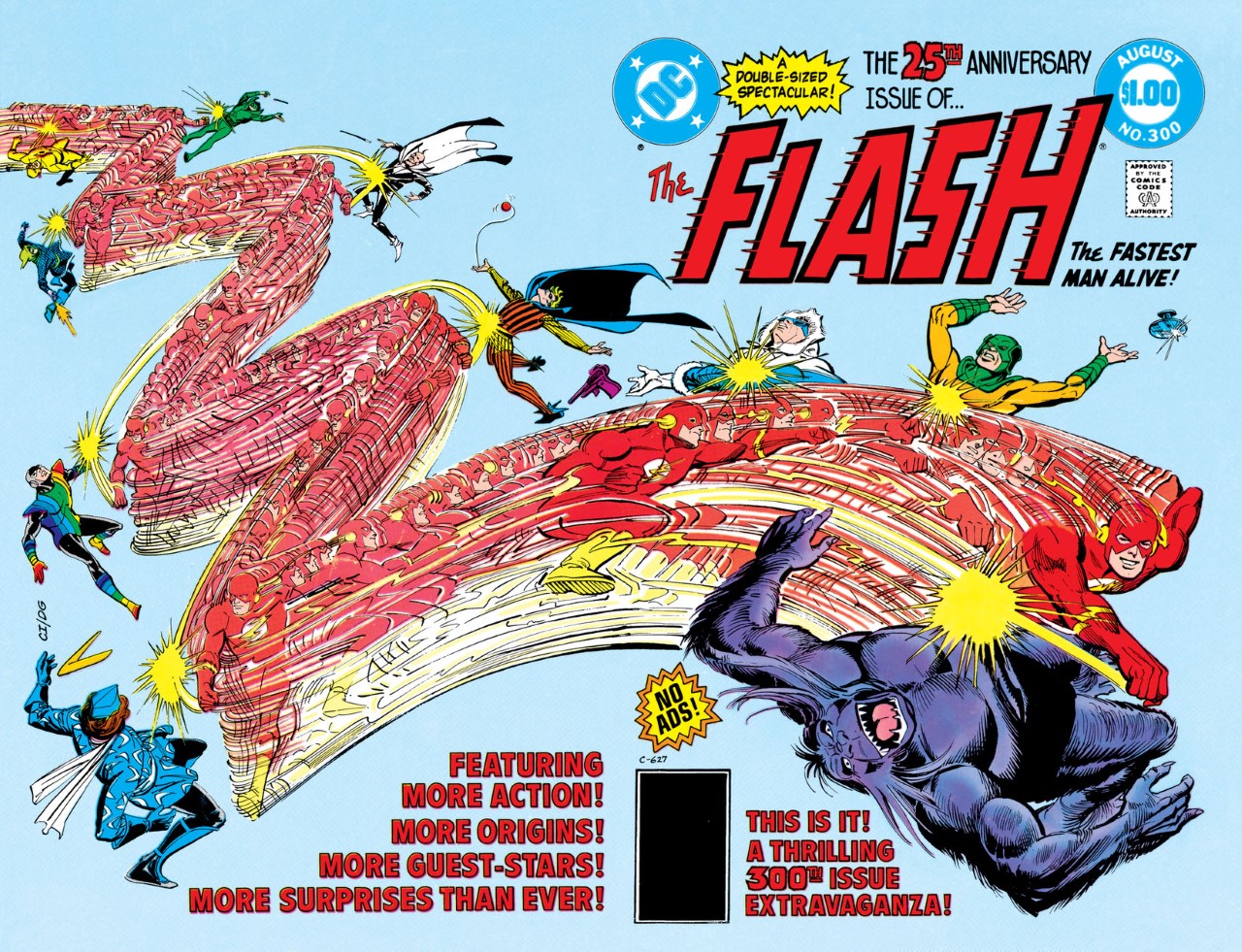
How’d We Get Here? After debuting in Showcase #4 (Oct. 1956) and appearing in a few more issues of the tryout book, the Silver Age Flash (Barry Allen) graduated to his own title, The Flash (March 1959), which picked up numbering (#105) from where the Golden Age series, Flash Comics, featuring Jay Garrick, left off (#104, Feb. 1949). The Barry Allen version of the Flash was the beacon of the Silver Age and he had a long and successful run. Or did he?
The Story: In this double-sized 25th anniversary issue (and a Dollar Comic to boot!), long-time Flash scribe Cary Bates and recently returned (as of #296) co-creator/artist Carmine Infantino (with Bob Smith on inks) take us through 1981: A Flash Odyssey.
Seemingly paraplegic, Barry Allen is decked out in bandages from head to toe like a mummy. It appears that the freak accident that happened in the police lab many years ago DIDN’T give him the gift of super-speed and a career as the Flash. Instead, Barry’s body and mind were scarred and he’s been hospitalized ever since. Dr. Petrou, his mysterious psychiatrist, insists that his storied career as the Scarlet Speedster is just a figment of his overactive, bed-ridden imagination. In essence, the Flash NEVER EXISTED!
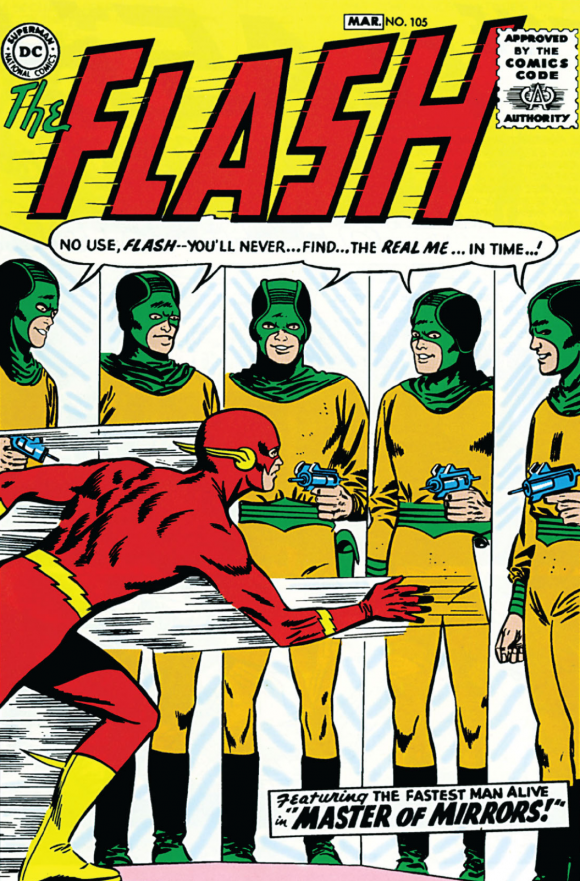
Barry, however, remembers things differently and his mind races through not only his origin, but those as well of his allies (Kid Flash, Jay Garrick, and the Elongated Man) and his vast Rogues Gallery. But nothing he says makes Dr. Petrou believe that he’s telling the truth. In fact, the good (?) doctor has a few tricks up HIS sleeves to convince Barry that he’s going insane.
The first is the reveal that Iris West is ALIVE and was never Barry’s wife. But how can that be? She was killed by Professor Zoom, the Reverse Flash, back in #275! Next, Dr. Petrou resorts to producing the Reverse Flash (out of thin air mind you) to prove to Barry once and for all that his whole life has been a lie. And to show there are no hard feelings, Zoom removes Barry’s bandages at super-speed…
Which is the final evidence Barry needs before he springs into action as…THE FLASH?! As he carries on a remarkable two-sided conversation with himself, Barry/Flash reveals in a Scooby-Doo moment that Dr. Petrou is in reality Abra Kadabra, the evil magician from the 64th Century. And he would have gotten away with it too if he wasn’t tripped up by his vain need for applause (which Barry overheard from the other room while “Petrou” was conjuring Zoom) as well as his mistake in creating the Reverse Flash in the first place. Because if the Flash NEVER EXISTED, how could there be a REVERSE Flash?
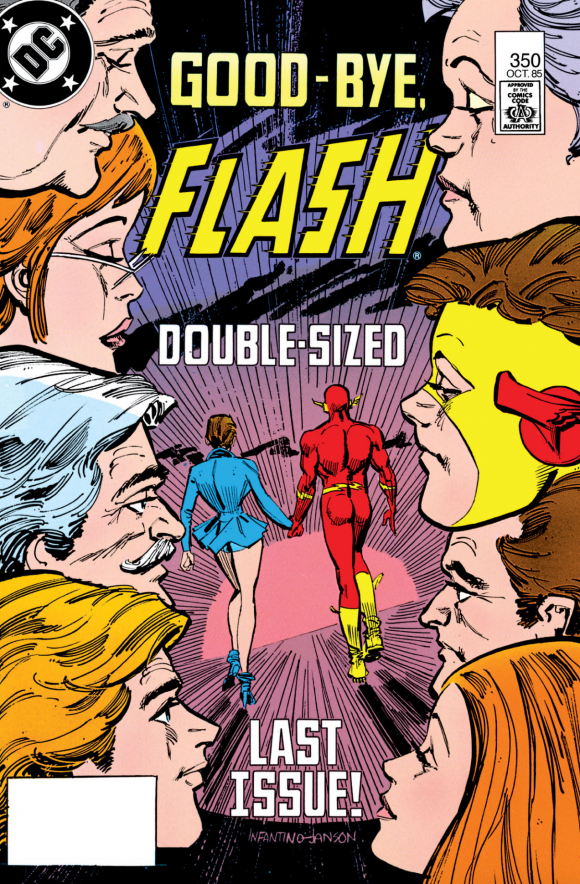
Notes: Cary Bates really delivers a solid script that takes the reader down memory lane and also serves as a primer if you’re a first time reader. Carmine Infantino’s art isn’t what it used to be but it’s nice to have the original artist/designer of the majority of these characters make his return to the book. And he turned in the beautiful wraparound cover too.
The Barry Allen version of the Flash would eventually bow out of the DC Universe (for about 23 years) in The Flash #350 and Crisis on Infinite Earths #8. When he returned, in Flash: Rebirth, his origin would be intertwined with that of the Reverse Flash, who, in a grandfather paradox, caused the accident that created the Flash.
—
2. Action Comics #500 (October 1979)
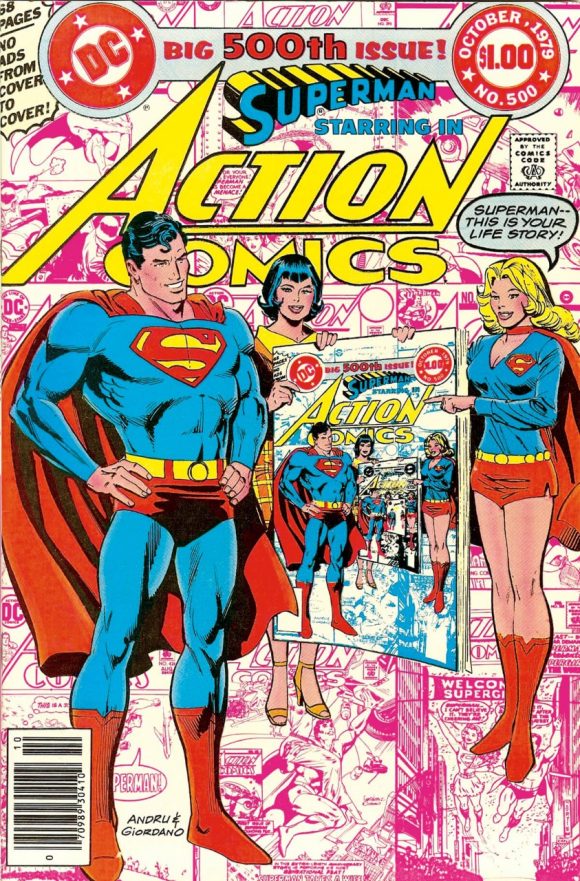
How’d We Get Here? Action Comics #1 debuted in June 1938 and featured the first appearances of Zatara, Marco Polo, Chuck Dawson, Pep Morgan, Scoop Scanlon and Tex Thomson (later Mr. America). Oh, and another character named… Superman.
The Story: At the dedication of the Superman Pavilion at the Metropolis World’s Fair, Superman retells his life story (The Life Story of Superman, duh, written by Martin Pasko with art by Curt Swan and Frank Chiaramonte), covering everything (Jor-El, Lara, Krypton, Krypto, Supergirl, Jimmy Olsen, Lois Lane, The Daily Planet, Lori Lemaris, Kryptonite (all flavors), Brainiac, the Bottle City of Kandor, the Phantom Zone, the Legion of Super-Heroes, Toyman, Lana Lang, Smallville… whew!).
Hmmm? Lex Luthor? Oh… he’s busy behind the scenes creating a Superman clone filled with Superman’s memories that he will control… Mwah Ha Ha!

Notes: A similar style plot would be used in the Superman and His Incredible Fortress of Solitude issue of DC Special Series #26 (Summer 1981), as Superman tells the history of the Fortress and the trophies inside, all the while a behind-the-scenes Lex Luthor plots to blow up the joint and (by chain reaction) the Earth.
Personally, I would have preferred the team of Swanderson (Curt Swan and Murphy Anderson). Nothing against Mr. Chiaramonte. And speaking of personally…
How Did I Get Here? I was regularly buying Superman during this year and started to pick up Action Comics as well (starting with #497). Quickly I realized that the 500th issue was coming up soon! I wasn’t aware of ANY other series reaching the 500 mark (I didn’t know about Dell’s Four Color, for example, at the time). And then the house ads started to hit! A Dollar Comic, Special Collector’s Edition? On sale July 16th? YESSSS!
Unfortunately, fate would rear it’s ugly head. Well, not fate. My mother. It’s kind of fuzzy (because of the on-sale date being AFTER school had already been out for awhile) but I was BANNED from buying “funny books” ANYMORE because of bad grades, or bad report card comments by the teacher about talking in class, or some other BS. And BS is what it was because I was a great student, not a sports/outside play kid, and comic books were my one vice. Nevertheless, the ban hit just before Action Comics #500 would have hit the stands.
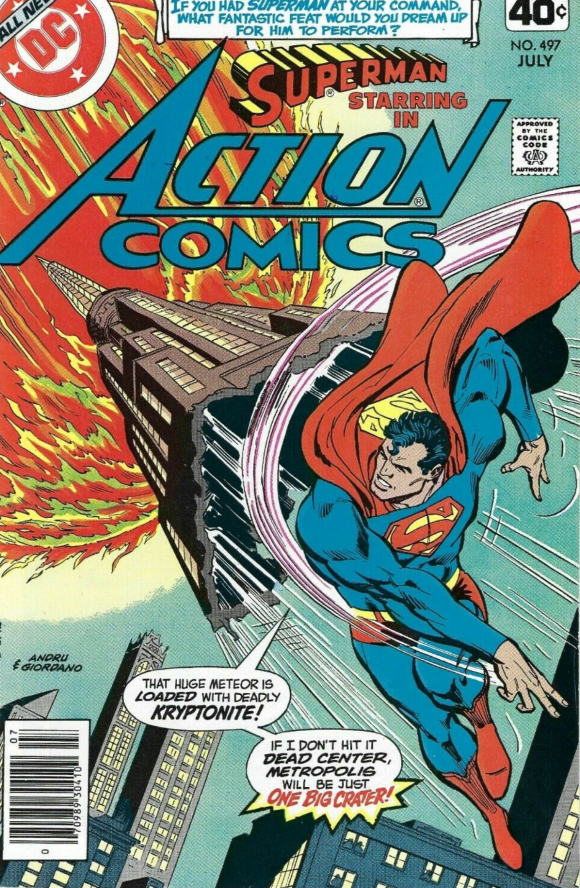
The ban lasted for about a year and I eventually got my mother to allow me to purchase “just special issues and anniversary issues.” I figured convincing her I was only buying comics that would go up in value (I had an Overstreet Price Guide to back me up after all) would be the way to go. But eventually, EVERYTHING (annuals, miniseries, movie adaptations, origin issues) became a “SPECIAL ISSUE”.
Forty years later, she occasionally brags about my “beautiful comic collection”. Um, yeah… thanks. 🙁
Oh, Action Comics #500 was one of the first back issues I bought when the ban was lifted and I was introduced to a comic book store.
—
1. Justice League of America #200 (March 1982)
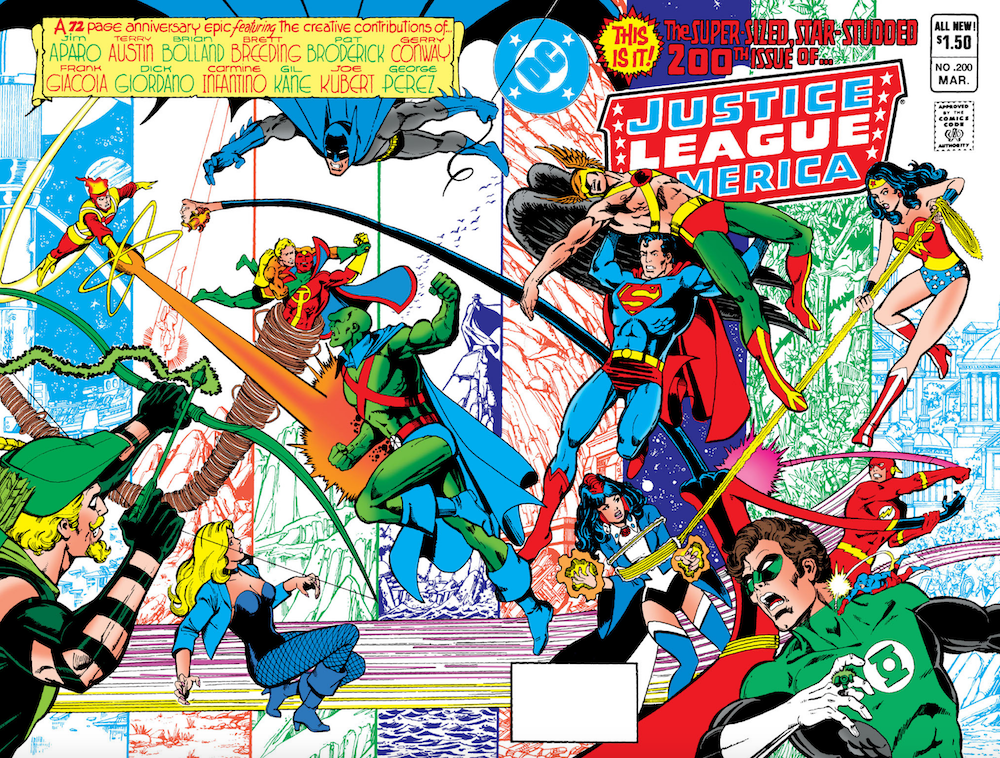
How’d We Get Here? After appearing individually in their own titles or back-up strips, seven heroes (Superman, Batman, the Flash, Green Lantern, Wonder Woman, Aquaman and the Martian Manhunter) band together to fight crime, super-villains and giant starfish aliens as the Justice League of America in Brave and the Bold #28 (March 1960). After two more appearances in the tryout comic, they graduated to their own title in November 1960.
The Story: In “A League Divided” (written by Gerry Conway with framing sequence, epilogue and cover art by George Perez), the original seven members of the JLA are mind controlled by the Appellaxian aliens (a post-hypnotic suggestion from their first encounter way back in Justice League of America #9, which was a flashback to the origin of the Justice League). Their mission is to retrieve seven Appellaxian meteorites that date back to their arrival many years ago. Once assembled together, the aliens will be reborn and they will conquer the Earth.
However, when Firestorm (on monitor duty in the JLA Satellite) battles an invading Martian Manhunter for the meteorite that’s in the JLA trophy room, he gets the feeling that something might be wrong. He signals the entire JLA (and is unable to contact the members under alien control). The arriving members (Green Arrow, Black Canary, The Atom, Elongated Man, Zatanna, Red Tornado, Hawkman… AND SNAPPER CARR?!) come to the realization that they’ll have to go up against their teammates to get to the bottom of this.
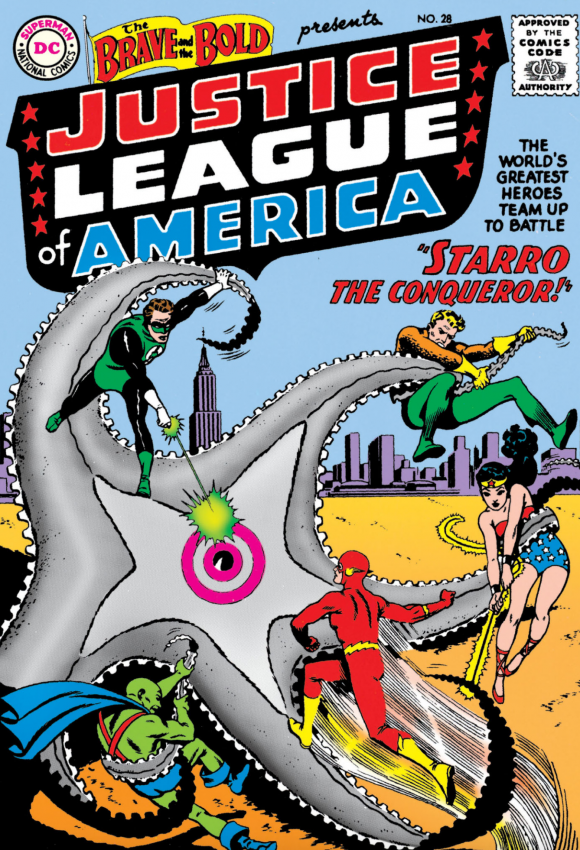
In grand old JLA fashion, they split up. Red Tornado takes on Aquaman (drawn by Jim Aparo), with the Phantom Stranger intervening (WTF with that guy?!) on behalf of the Sea King. Zatanna visits Paradise Island and takes on Wonder Woman (art by Dick Giordano). The Atom is beaten by Green Lantern (art by co-creator of both heroes, Gil Kane). The Elongated Man is defeated by the Flash (art by co-creator of both heroes, Carmine Infantino). Green Arrow and Black Canary are unable to take down Batman (art by Brian Bolland). And finally, Hawkman is destroyed by Superman (art by Joe Kubert), who leaves the Winged Wonder floating unconscious in space. Luckily, honorary JLAer Adam Strange is on hand to lend some Zeta Beam support.
While the beaten Leaguers return to the Satellite to lick their wounds, the victorious ones head for their old cave headquarters in Happy Harbor. It’s there that their memories return, just as the Appellaxians are reborn from the gathered meteorites. The Original Seven are no match for them. They meet up with the Satellite team and split up again, this time in greater numbers, to go after the aliens.
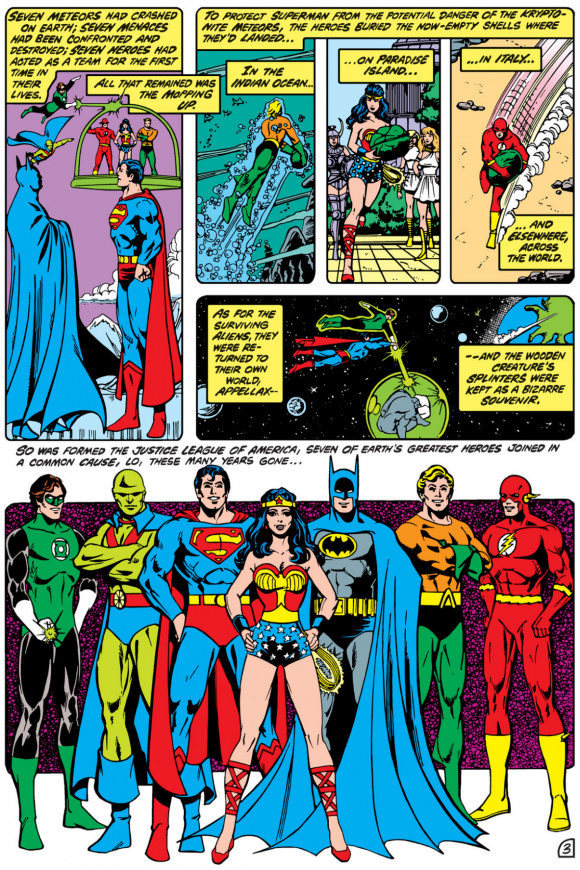
Batman, Black Canary, Green Arrow, Hawkman, Superman, Wonder Woman and Zatanna take on the wooden, crystal and mercury aliens. Aquaman, Red Tornado, the Flash, and Elongated Man tackle the glass and fire monsters. The Atom, Green Lantern, Firestorm and the Martian Manhunter destroy the stone and golden bird creatures.
With the threat over, ex-members Snapper Carr and Martian Manhunter once again leave the group to pursue other interests. Green Arrow (who had quit the team in #181) decides he’s going to stick around.
Notes: Not only is it the Greatest Anniversary Issue of All-Time, it’s one of the greatest comics, period. Longtime JLA scripter Gerry Conway is really firing on all cylinders and just GETS the team dynamic among these varied and legendary heroes. The story is a nice call back to the JLA’s origin but it gives us something new too — Leaguers against Leaguers like never before, instead of just a walk through old adventures and memories. Although, I’d have loved a story that did that too, like what happened in Action #500 or Flash #300, or even the non-anniversary issue of Avengers #151.
The art? Well Perez is Perez. C’mon. Like Conway, he really gets these characters. Everyone is on model. And no one does multi-character battles royale like George Perez. Unfortunately this would be his swan song (what a way to go out!) on the interior pencils (having begun working on the book with #184, inheriting the title due to the untimely demise of the legendary Dick Dillin). Perez would continue to do covers for JLA off and on until #220.
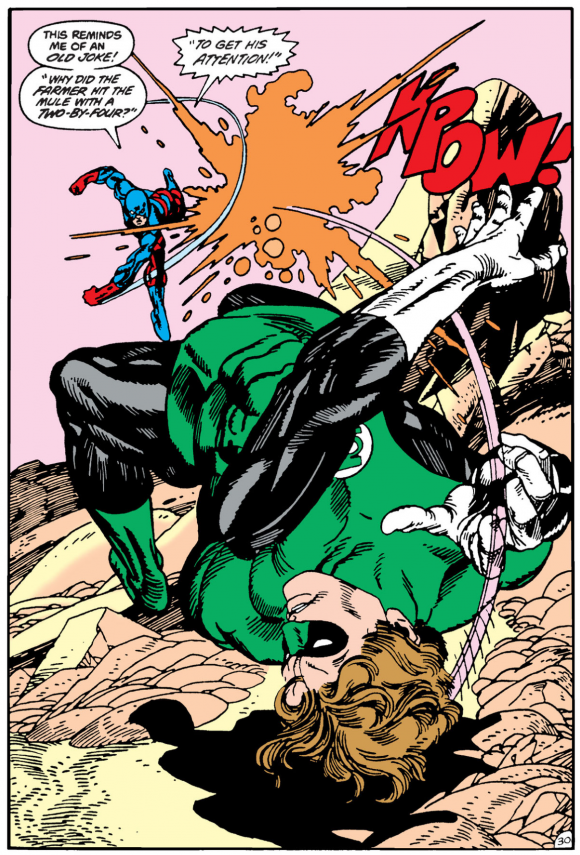
For the interior art, DC really did a great job securing some of the best artists in its history for the individual JLA vs. JLA chapters. Jim Aparo is synonymous with Aquaman and the Phantom Stranger. Same for the characters Gil Kane and Carmine Infantino worked on. Dick Giordano had done previous Wonder Woman work and he’s was a great “girl art” artist in general. When you think Superman you don’t necessarily think Joe Kubert but Hawkman, yeah that’s a different story. For the Batman/Green Arrow/Black Canary section, I’m assuming Brian Bolland was chosen as sort of a nod to the art style of Neal Adams, who famously worked on those characters. Bolland would also make his own mark on Batman in 1988 with The Killing Joke.
While it was great to see honorary Leaguers like Snapper (or dishonorary?), the Phantom Stranger and Adam Strange… where was Hawkgirl?
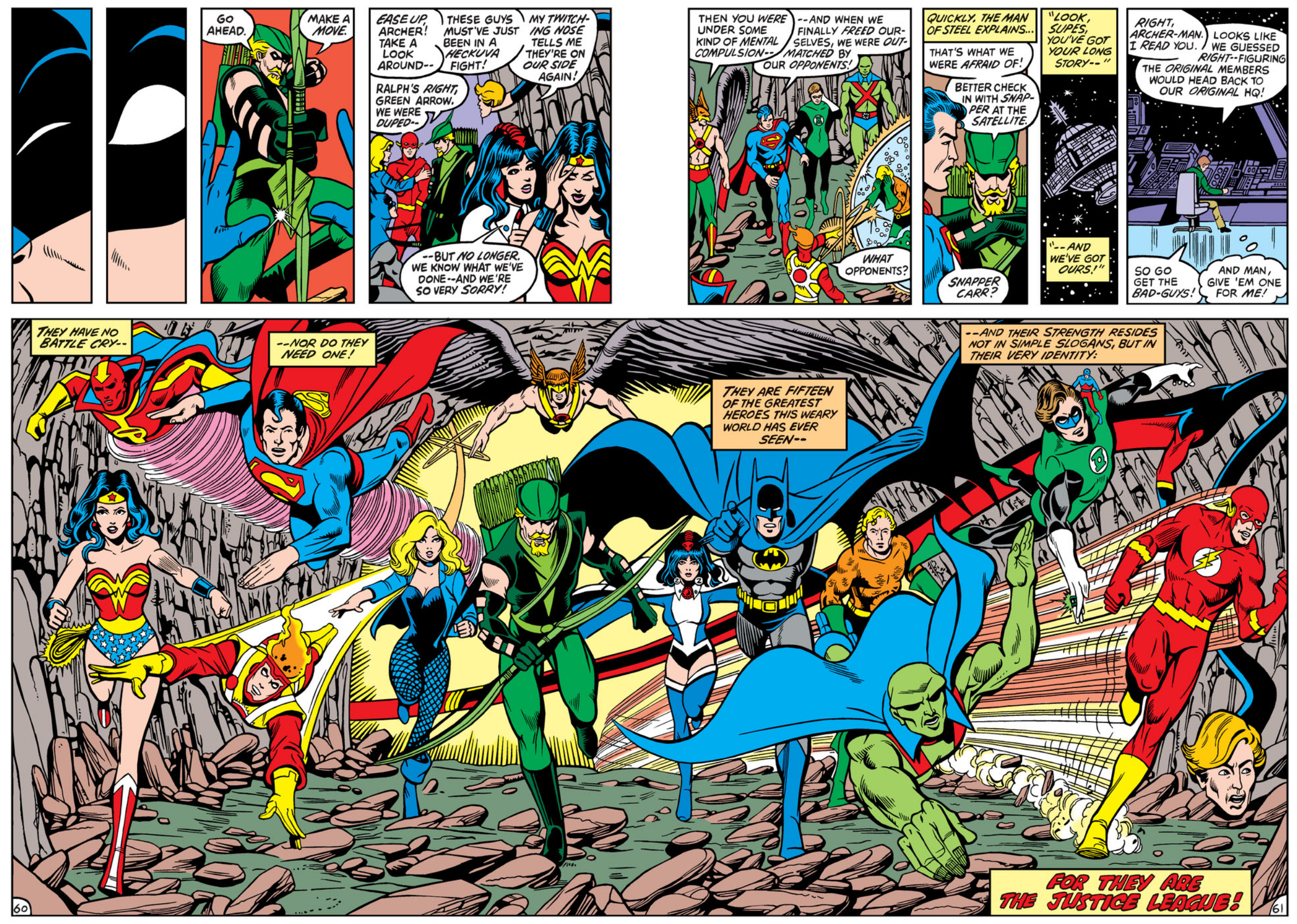
You know, this is also probably the Greatest JLA Story Ever Told. To me, the Satellite Era of the Justice League is the best. It’s what I grew up on. From the Original Seven to Firestorm, they’re all valid (even if Alex Ross stops short before Ol’ Matchhead joined). The JLA wouldn’t get any better than this. It never happened. A few years from now (beginning in Justice League of America Annual #2, October 1984), everything would be turned upside down with the introduction of JLA Detroit. And after that the Crisis on Infinite Earths hit and we’d never get this team back again.
Black Canary would replace Wonder Woman as a founding member, until Wonder Woman replaced her again. The Martian Manhunter would lose his spot as a founding member to… Cyborg. And while the JLI Bwah-Ha-Ha era was fun at the time, it really wasn’t the JLA, was it? Heroes that had no business as members of the illustrious JLA would join the team. Yeah I’m taking about such stalwarts as Triumph, Manitou Raven, Bloodwynd, Crimson Fox, Aztek, Tomorrow Woman, Congorilla, and Blue Jay. Ugh.
The only thing that would’ve made this better would’ve been if it was released as a TABLOID EDITION! Hey, DC, any way we can get that on the schedule coming up? Or a hardcover version! Ooooooo!
—
MORE
— 13 REASONS to Love DC COMICS in the Bronze Age. Click here.
— Dig These 13 Funky DETECTIVE COMICS #1027 Variant Covers. Click here.

September 13, 2020
I have to agree with you on the JLA. The ‘70s rocked it! The JSA team-ups to the Red Tornado to some of the greatest covers ever! And, I’m fine with Firestorm too.
As for the anniversary issues, I remember buying most of them. But, my favorite hands down is BATMAN 200 from the Silver Age.
September 13, 2020
Very enjoyable read–thanks!
September 13, 2020
This is an article I greatly appreciate and value. It makes me feel quite nostalgic about the good old days.
September 13, 2020
Very nice review of these 13 issues, but obviously you have them in the wrong order. 😉
The Legion anniversary seems to have included everything you were asking for, yet you left it below the middle range? The JLA story features Joe Kubert on Superman instead of Curt Swan, but that’s OK with you? And the non inclusion of Hawkgirl means this issue just can’t be the best. Gerry Conway didn’t even give us a one-line reason for her absence!
But the 13 issues WERE great, and I remember reading all of them back in the day,
September 13, 2020
As for why Hawkgirl wasn’t JLA 200, it was actually a nod to the current continuity as she was off world in the Hawkman feature in World’s Finest. Though the fans would have been fine with ignoring continuity if Hawkgirl was in it.
In Superman Family 200, Supergirl’s mystery boyfriend was implied to be Dick Grayson (confirmed in a letter column to be who they had in mind).
Doug Moench did not want to reuse the escaped villain in the Bane storyline but was told he had to.
I have all of these and can’t disagree with the number one pick.
September 13, 2020
Actually, Detective #1026, if anything, is the 1000th bat-issue. If #27 was the first, then #1027 is the thousand-and-first, isn’t it? (Are we going to count the issues Batwoman headlined?)
September 14, 2020
Decent write-up of LSH #300, but they missed the most important point: the divorcing of “our” Legion from the predictions of the Adult Legion story. LSH #299 had deliberately set up a cliffhanger about whether Shadow Lass / “Shadow Woman” was about to die protecting the Science Asteroid, as predicted by her memorial statue in the Adult Legion’s HQ, but the outcome of LSH #300 (not even mentioned in this article!) proved that that had been just one possible timeline. That was the reason for the multiple-possible-futures format of the anniversary issue!
September 14, 2020
Apparently, I was a sucker for an anniversary issue… I had all of these except for Showcase and Flash. That Superman 400 issue was a dazzling barn-burner! Loved the Brave and the Bold 200, also. Dave Gibbons, drawing in two different styles was pretty awesome!
September 15, 2020
Great list Anthony! And the order is pretty much how I would rank them, although I would put ‘Tec #526 over Batman #400, just because it got there first, and because I love that boss Jason Todd Robin costume…which he should have kept.
That Batman/Deadman story in ‘Tec #500 has always seemed out of place with me, but when you have THE GREATEST BATMAN STORY EVER TOLD, “To Kill A Legend” in your comic, who cares?
If only Action #500 had been a treasury/tabloid comic like it was supposed to, maybe your Mom would have been swayed by it’s collector appeal, even in the midst of your Phantom Zone-like banishment.
Again, great article!
September 15, 2020
Detective #500 should have been #2, Showcase #100 #3, and Superman #400 #4 ;D. Still a great list and overview! I’m pretty sure the Batman/Deadman team-up in Detective #500 so that artist Carmine Infantino could have a part in the occasion. He was THE Batman artist in the 60s, until Neal Adams came along. Plus, Infantino drew the debut of Deadman…
September 16, 2020
I agree DETECTIVE COMICS #500 should be higher.
I don’t mind the Batman/Deadman story but leaving Batgirl out was a mistake, they should have found a place for her.
Also to be complete there was an amusing one page Bat-Mite story in The Brave and the Bold #200.
September 16, 2020
Superman 400 was the single greatest issue of that series. An absolutely amazing line-up of artists. And since the stories were out of continuity, it still holds up beautifully. With that all-star line-up, I’m completely baffled as to why DC has never released it as a hardcover Deluxe Edition.
September 18, 2020
Fun article, DC really does rule when it comes to anniversary issues. I don’t care about rankings so much as reminders of some great issues. Other terrific gold anniversary issues you likely considered include New Adventures of Superboy #50 and World’s Finest Comics #300. Wonder Woman #300 was another splendid giant from around this time. Going way back, it wasn’t billed as an anniversary issue, but Action Comics #300 has one of my favourite stories of all time, ‘Superman under the red sun’, which – shockingly to me – seems to have been reprinted nowhere but in a black and white Showcase volume. It’s a stunning tale.
Regarding Superman #400, Anthony, you write: ‘There are no super-villains, just ordinary people who’ve been caught up in and inspired by the Superman mythology and his message of hope. In case you didn’t know what the “S” stands for…’
But it didn’t mean ‘hope’ back then, that was a Superman: Birthright tweak in the 2000s. I hate that Hope business, S stands for Superman!
Flash #300 really was clever stuff, I wonder if it inspired that Buffy episode in which she’s in the psychiatric institution… then again, it’s entirely likely the idea had been done previously.
May 18, 2021
Absolutely loved JLA #200 — other than its omission of Hawkwoman, darn it — and it would be my top ranked pick, too. I always loved Action Comics #484, under the banner “40th Anniversary Issue” and featuring the marriage of Superman and Lois Lane on Earth-2. Beautifully done. That would be my #2 pick on a list like this. Some might argue that the issue wasn’t giant-sized, but I would counter that Superman Family #200 on this list was not oversized compared to previous issues, either.
September 27, 2023
Regarding World’s Finest and all of the Superman, Batman, and/or Robin historical meet-ups: Boy, Earth-2 sure absorbed a lot of continuity conflicts, didn’t it? Sure would have made for a better COIE outcome if Earth-2 and a couple of others had survived. And isn’t it about time for an Earth-2 omnibus?
September 28, 2023
Oh I LOVE these! I think I read almost all of them and actually still have some of them! My favorites? The Superman #400 story that riffed on the story of the Prophet Elijah as Reilly is holding the dinner for his family (wearing a Superman shirt) and is the only person at the table to realize that the stranger in the Superman suit they welcomed to their celebration and sat in the only available chair, the empty chair traditionally reserved for Superman who vanished in the 21st century actually is Superman. The Man of Steel is moved and inspired by the stories of him that Reilly tells and the smile on his face is wonderful! Showcase #100. Loved it from beginning to end, including Sugar and Spike who I don’t think appeared in Showcase! JLA #200. I’d read the retelling of their origin in (I think!) Issue #98 when they’d gotten their butts kicked by Starbreaker. A writer to the letter column a few issues later mentioned that they liked that the story had been (we’d call it “retconned” today) changed so the JLA didn’t kill the Appelaxians. And I loved the twist that the Appelaxians AREN’T dead at all! “To Kill a Legend” in Detective #500. Absolutely loved it! To the extent that a few years ago I dug it out of a crate and reread it! (I’ll have to dig it out again, I didn’t note Walter Gibson’s byline! He’s a literary hero of mine!) And I loved the “It Was a Dark and Stormy Night” story! Charles Schulz is another hero of mine! When I was a kid reading these, I read for the “special effects” Super-powers, magic, ect.. Now, I realize that I was grabbed by the power of story and the writing and artwork. The creative people are my heroes, and I am a writer today! To quote Supes’ last line in Action #500: “You might say it’s the story of my life!” Thanks so much for this!
September 28, 2023
Oh, and I loved one I didn’t mention Flash #200 which I found at a used store in Albuquerque around 1976 or so. They stuck a bunch of references to the number 200 in the story! LOL!
September 28, 2023
Hawkgirl wasn’t there because she was separated from Katar and on Thanagar. Of course, J’onn was of planet and suddenly returned, but I guess the difference was that he was under the influence of the aliens while Shayera would not have responded to the signal alert
September 23, 2025
>> Although it would have been nice to have had a full-size comic commemorating the….
>>
Hey, DC, I smell facsimile edition but in full size! Shoot…many of these could be ones too.
September 23, 2025
I would have added Tales of the Teen Titans 50 to this list. The issue where Donna Troy gets married. That book was so popular at the time that they could use some of that goodwill from the fans and release a 48-page issue of a super-hero comic in which none of the characters are in costume and there’s not a single fight scene.
September 24, 2025
Thanks so much for reposting this article. I love the DC anniversary issues, especially the gold-bannered ones from the 80s. I have been trying to get as many as possible signed by the creators. I started in 2018 when I met Gerry Conway at a convention in Montreal and he was kind enough to sign Detective 526 one of my all-time favourite single Batman issues. Then I was able to obtain Paul Levitz who graciously signed Legion 300. The next one was Paul Kupperburg on Superboy 50. And the last ones I got were from Cary Bates on both Action 544 AND Flash 300. Thanks again to all of these creators for their wonderfully works and for taking the time to sign my books. Which are all on display in my house. All of this said, the DC anniversary issue I probably read the most often and beat up the most was Action 500. I was really into the Mego figures at that time, and I thought that Ross Andru’s Superman crest on the cover was so nice that I cut it out and pasted it onto my mego Superman figure to replace the crest on his costume which had fallen off and disappeared.
September 24, 2025
It is safe to say that Justice League of America #200 is sort of an obsession book for me. It is my all time favorite title and issue #200 did not disappoint.
September 25, 2025
Ditto to the kudos already posted. I wish DC would put some of these (LSH #300, Showcase #100, Superman #400 and JLA #200) out in facsimile editions, or at least digitally for those that are not thusly already available.
Even better, how about an “anniversary issue omnibus” with text pieces by some of the editors and creators? And a version of this article for the intro? (Dan, I think this is a pitch you should make to DC!)
October 1, 2025
What a great list! It is a nice trip down memory lane just reading through this. As a Lagion fan, I think LSH #300 should be at the top of the list. Well, okay, JLA #200 is pretty awesome, but LSH #300 should be #2, anyway!
November 30, 2025
Some have raised the idea of a DC Finest that would focus on special anniversary issues such as these. Wouldn’t the issues selected here make for a great book!